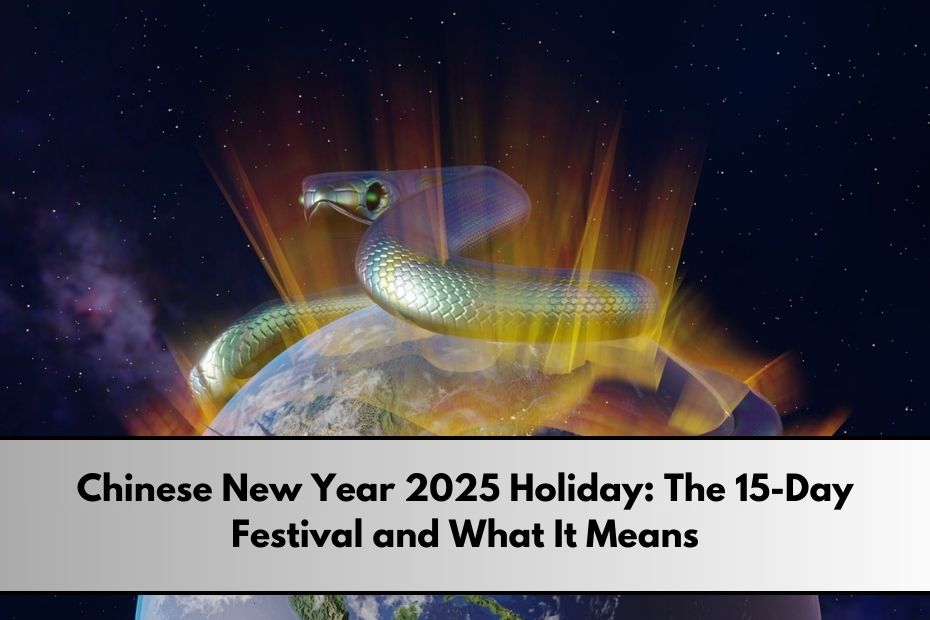Chinese New Year, also known as Spring Festival, is the most significant traditional holiday in China and is celebrated by millions of people around the world. It marks the beginning of the lunar new year, which falls on a different date each year but generally takes place between late January and mid-February. In 2025, Chinese New Year will begin on Saturday, January 29, and the festivities will last for 15 days, culminating in the Lantern Festival on February 13, 2025. This holiday brings families together, honors ancestors, and welcomes the energy of the new lunar year. Here’s a deeper look at the dates, traditions, and the full duration of Chinese New Year 2025.
Chinese New Year 2025 Dates:
- Chinese New Year Eve (Reunion Dinner): January 28, 2025
- The celebration begins the night before Chinese New Year with a reunion dinner. This is the most important meal of the year, where family members, no matter how far apart, make a special effort to come home. It’s an emotional and festive time, filled with dishes that are believed to bring good fortune.
- Chinese New Year Day: January 29, 2025
- The official start of the Chinese New Year. It’s a time for visiting relatives and friends, and for honoring ancestors. Many people wear new clothes (often red) to signify a fresh start. Fireworks and firecrackers are common to celebrate the beginning of the new year.
- Lantern Festival: February 13, 2025
- The Lantern Festival, which occurs on the 15th day of Chinese New Year, marks the end of the holiday. It is characterized by spectacular lantern displays, lion dances, and parades. Lanterns are often shaped like animals or mythical creatures, symbolizing good fortune and the hope for peace in the year to come.
Why Does Chinese New Year Last 15 Days?
Chinese New Year is celebrated for 15 days to allow ample time for various customs and rituals. Each day of the festival has its own meaning, and the extended time period ensures that people can enjoy all the festivities and family activities. The holiday includes time for reflection, honoring ancestors, paying off debts, cleaning, and preparing for a prosperous year.
- The first 5 days are often focused on family, rest, and celebration.
- The middle days are used for paying respect to elders and ancestors, as well as for entertaining friends and guests.
- The last days lead up to the Lantern Festival, which marks the final day of celebrations.
Chinese New Year Traditions and Customs:
- Family Reunions: The reunion dinner on Chinese New Year’s Eve is one of the most important traditions. Family members travel great distances to come together and share a feast. This meal is a symbol of unity and good fortune, and every dish is chosen for its positive symbolism. For instance, fish (yú) symbolizes surplus and prosperity, while dumplings (jiaozi) represent wealth.
- Red Envelopes (Hongbao): One of the most anticipated traditions during Chinese New Year is the giving of red envelopes or hongbao. These envelopes are filled with money and gifted to children, unmarried adults, and sometimes employees. The money is meant to bring good luck, happiness, and wealth. The red color represents good fortune and is believed to ward off evil spirits.
- Fireworks and Firecrackers: Fireworks and firecrackers are essential elements of the celebration. They are set off on New Year’s Eve and continue throughout the first days of the festival. The loud noises are believed to scare away evil spirits and bad luck, while also welcoming the new year with joy and excitement.
- Traditional Foods: Food plays a significant role in Chinese New Year celebrations, and certain dishes are considered lucky because of their symbolic meanings:
- Dumplings: Represent wealth and prosperity.
- Noodles: Symbolize longevity, and they are often served uncut.
- Fish: Symbolizes surplus and abundance.
- Rice Cakes (Nian Gao): Represent progress and growth.
- Mandarins and Oranges: Symbolize wealth and good luck.
- Lion and Dragon Dances: Traditional lion dances and dragon dances are common during Chinese New Year. These dances, accompanied by drumming, symbolize the chase of evil spirits and the welcoming of good fortune. Performers in colorful costumes mimic the movements of lions and dragons to bring prosperity to the community.
- House Cleaning and Decoration: Before the Chinese New Year begins, families typically engage in spring cleaning to rid their homes of bad luck and make way for good fortune. Homes are decorated with red lanterns, couplets, and paper cuttings featuring symbols of luck, prosperity, and happiness. The color red is predominant in decorations, as it is considered a powerful color that brings good fortune.
- The Lantern Festival: On the final day of Chinese New Year, the Lantern Festival marks the conclusion of the celebrations. This event is known for its stunning displays of colorful lanterns in various shapes, such as animals, flowers, and mythical creatures. There are also public events like traditional dances, games, and performances, including the famous “guessing the riddles on lanterns” activity.
Conclusion: Chinese New Year 2025
Chinese New Year 2025 is set to be a grand celebration that spans 15 days, beginning on January 29, 2025 and concluding on February 13, 2025. During this period, families will come together, fireworks will light up the sky, red envelopes will be exchanged, and cultural traditions will be honored. Whether you’re participating in family dinners, enjoying the colorful lanterns, or indulging in lucky foods, the celebration will be a time of joy, reflection, and renewal.
As we approach the start of the Lunar New Year, take this time to reflect on the past year and embrace the future with positivity and hope. This holiday is not just about celebrating the beginning of a new year, but also about reconnecting with loved ones, cherishing traditions, and looking forward to prosperity and happiness in the year to come.

